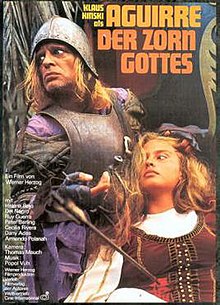
Back أجيرا، غضب الرب (فيلم) Arabic اجيرا, غضب الرب ARZ আগির্রে, ডের ৎসর্ন গটেস Bengali/Bangla Aguirre, gnjev Božiji BS Aguirre, la còlera de Déu Catalan Aguirre, hněv Boží Czech Aguirre, The Wrath of God Welsh Aguirre, den gale erobrer Danish Aguirre, der Zorn Gottes German Αγκίρε, η Mάστιγα του Θεού Greek
| Aguirre, the Wrath of God | |
|---|---|
 German theatrical release poster | |
| German | Aguirre, der Zorn Gottes |
| Directed by | Werner Herzog |
| Written by | Werner Herzog |
| Produced by | Werner Herzog Walter Saxer |
| Starring |
|
| Cinematography | Thomas Mauch |
| Edited by | Beate Mainka-Jellinghaus |
| Music by | Popol Vuh |
Production companies | |
| Distributed by | Filmverlag der Autoren[1] |
Release date |
|
Running time | 94 minutes |
| Countries | |
| Language | German[5] |
| Budget | US$370,000[6] |
Aguirre, the Wrath of God (Spanish: [aˈɣire]; German: Aguirre, der Zorn Gottes; [aˈɡɪʁə deːɐ̯ ˌtsɔʁn ˈɡɔtəs]) is a 1972[2] epic historical drama film produced, written and directed by Werner Herzog. Klaus Kinski stars in the title role of Spanish soldier Lope de Aguirre, who leads a group of conquistadores down the Amazon River in South America in search of the legendary city of gold, El Dorado. The accompanying soundtrack was composed and performed by kosmische musik band Popol Vuh. The film is an international co-production between West Germany and Mexico.
Using a minimalist approach to story and dialogue, the film creates a vision of madness and folly, counterpointed by the lush but unforgiving Amazonian jungle. Although loosely based on what is known of the historical Lope de Aguirre, Herzog acknowledged years after the film's release that its storyline is a work of fiction. Some of the people and situations may have been inspired by missionary Gaspar de Carvajal's account of an earlier Amazonian expedition, although Carvajal never accompanied Aguirre on any of his expeditions.
Aguirre was the first of five collaborations between Herzog and Kinski. They had differing views as to how the role should be played, and they clashed throughout filming; Kinski's rage terrorized both the crew and the locals who were assisting the production. Shooting took place entirely on location, and was fraught with difficulties. Filming took place in the Peruvian rainforest on the Amazon River during an arduous five-week period, shooting on tributaries of the Ucayali region. The cast and crew climbed mountains, cut through heavy vines to open routes to the various jungle locations, and rode treacherous river rapids on rafts built by local craftworkers.
Aguirre opened to widespread critical acclaim, and quickly developed a large international cult following. It was given an extensive arthouse theatrical release in the United States in 1977, and remains one of the director's best-known films. Several critics have declared the film a masterpiece, and it has appeared on Time magazine's list of "All Time 100 Best Films".
- ^ "Aguirre, der Zorn Gottes". Filmverlag der Autoren. Retrieved 5 August 2017.
- ^ a b "Aguirre, Wrath of God (1972)". British Film Institute. Archived from the original on 11 February 2016.
- ^ "Aguirre, der Zorn Gottes". Lumiere. Retrieved 17 March 2019.
- ^ "Aguirre, La Ira de Dios (Aguirre, Der Zorn Gottes) — ruidoblanco". Ruido Blanco FM (in Mexican Spanish). 3 October 2022. Retrieved 29 March 2023.
- ^ Overbey, David. Movies of the Seventies, pg. 162. Edited by Ann Lloyd, Orbis Books, 1984. ISBN 0-85613-640-9: The film was shot MOS in English, but was primarily released in a German-dubbed version.
- ^ "Business Data for Aguirre, der Zorn Gottes". Internet Movie Database. Retrieved 19 March 2007.